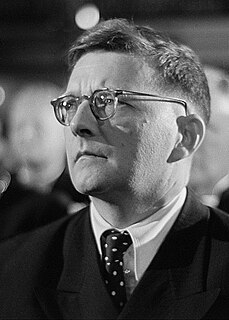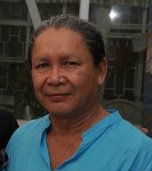
Dmitri Dmitriyevich Shostakovich was a Russian composer and pianist who became internationally known after the premiere of his First Symphony in 1926 and was regarded throughout his life as a major composer.
Dmitri Shostakovich's String Quartet No. 8 in C minor, Op. 110, was written in three days.

Alfred Garrievich Schnittke was a Russian composer of Jewish-German descent. Among the most performed and recorded composers of late 20th-century classical music, he is described by musicologist Ivan Moody as a "composer who was concerned in his music to depict the moral and spiritual struggles of contemporary man in [...] depth and detail."
Dmitri Shostakovich wrote his Symphony No. 2 in B major, Op. 14, subtitled To October, for the 10th anniversary of the October Revolution. It was first performed by the Leningrad Philharmonic Orchestra and the Academy Capella Choir under Nikolai Malko, on 5 November 1927. After the premiere, Shostakovich made some revisions to the score, and this final version was first played in Moscow later in 1927 under the baton of Konstantin Saradzhev. It was also the first time any version of the work had been played in Moscow.
The Symphony No. 5 in D minor, Op. 47, by Dmitri Shostakovich is a work for orchestra composed between April and July 1937. Its first performance was on November 21, 1937, in Leningrad by the Leningrad Philharmonic Orchestra under Yevgeny Mravinsky. The premiere was a "triumphal success" that appealed to both the public and official critics, receiving an ovation that lasted well over half an hour.

Dmitri Shostakovich’s Symphony No. 13 in B-flat minor, Op. 113, titled Babi Yar, was completed on July 20, 1962, and first performed in Moscow in December of that year. The hour-long work requires a bass soloist, men's chorus, and large orchestra and is laid out in five movements, each a setting of a Yevgeny Yevtushenko poem. This unusual form gives rise to various descriptions: choral symphony, song cycle, giant cantata. The five earthily vernacular poems denounce Soviet life one aspect at a time: brutality, cynicism, deprivation, anxiety, corruption. Kirill Kondrashin conducted the premiere after Yevgeny Mravinsky had declined the assignment under pressure; Vitaly Gromadsky sang the solo part alongside the combined choruses of the RSFSR State Academy and Gnessin Institute and the Moscow Philharmonic.

The Symphony No. 15 in A major, Op. 141, composed between late 1970 and July 29, 1971, is the final symphony by Dmitri Shostakovich. It was his first purely instrumental and non-programmatic symphony since the Tenth from 1953. Shostakovich began to plan and sketch the Fifteenth in late 1970, with the intention of composing for himself a cheerful work to mark his 65th birthday the next year. After completing the sketch score in April 1971, he wrote the orchestral score in June while receiving medical treatment in the town of Kurgan. The symphony was completed the following month at his summer dacha in Repino. This was followed by a prolonged period of creative inactivity which did not end until the composition of the Fourteenth Quartet in 1973.

Gennady Nikolayevich Rozhdestvensky, CBE was a Soviet and Russian conductor.
DSCH is a musical motif used by the composer Dmitri Shostakovich to represent himself. It is a musical cryptogram in the manner of the BACH motif, consisting of the notes D, E-flat, C, B natural, or in German musical notation D, Es, C, H, thus standing for the composer's initials in German transliteration: D. Sch..
Aubrey Williams was a Guyanese artist. He was best known for his large, oil-on-canvas paintings, which combine elements of abstract expressionism with forms, images and symbols inspired by the pre-Columbian art of indigenous peoples of the Americas.

Rasheed Araeen is a Karachi born, London-based conceptual artist, sculptor, painter, writer, and curator. He graduated in civil engineering from the NED University of Engineering and Technology in 1962, and has been working as a visual artist bridging life, art and activism since his arrival in London from Pakistan in 1964.

Alexander Ivashkin, was a Russian cellist, writer, academic and conductor.
Veniamin Efimovich Basner was a Russian composer. He was recognized by the Soviet Union as a People's Artist of Russia and a State prize-winner. An asteroid called 4267 Basner, discovered in 1971, was named in his honour. He was a member of the St Petersburg Union of Composers.

George Simon was a Guyanese Lokono Arawak artist and archaeologist. He was the founder and mentor of the Lokono Artists Group, a group of Lokono artists from Guyana, based primarily in Simon's hometown of St. Cuthbert's Mission. Simon was widely regarded as one of the leading Guyanese artists of his generation, and his paintings are notable for their explorations of Amerindian culture and the Guyanese environment. He was also recognized for his achievements as an educator, his efforts to develop opportunities for Amerindian artists in Guyana, and for his work as an archaeologist.
Edward Rupert Burrowes was a Guyanese artist and art teacher who founded the Working People's Art Class (WPAC), the first established art institution in Guyana. The E R Burrowes School of Art, an undergraduate institution accredited by the University of Guyana, is named after him.
The Working People's Art Class (WPAC), founded by Edward Rupert Burrowes in 1945, was the first established art institution in the colony of British Guiana, now the country of Guyana. A number of well-known Guyanese artists were taught at the WPAC.

The Olmec-Maya and Now (1981–1985) is a series of large, oil-on-canvas paintings by Aubrey Williams. The series grew out of Williams' enduring interest in pre-Columbian cultures of the indigenous peoples of the Americas. It explores parallels between Olmec and Maya civilizations and contemporary global culture, focusing in particular on the threat of rapid demise and self-destruction.
Anne Walmsley is a British-born editor, scholar, critic and author, notable as a specialist in Caribbean art and literature, whose career spans five decades. She is widely recognised for her work as Longman's Caribbean publisher, and for Caribbean books that she authored and edited. Her pioneering school anthology, The Sun's Eye: West Indian Writing for Young Readers (1968), drew on her use of local literary material while teaching in Jamaica. A participant in and chronicler of the Caribbean Artists Movement, Walmsley is also the author of The Caribbean Artists Movement: A Literary and Cultural History, 1966–1971 (1992) and Art in the Caribbean (2010). She lives in London.
The Five Fragments, Op. 42 by Dmitri Shostakovich is a suite for small orchestra. He drafted the score in a single day, on June 9, 1935. Upon completion, the score laid unperformed until its belated premiere nearly 30 years later. It was first performed in Leningrad on April 26, 1965 by the Leningrad Philharmonic Orchestra under the direction of Igor Blazhkov.








